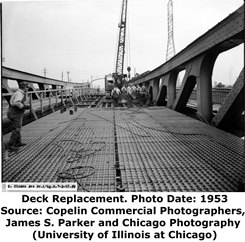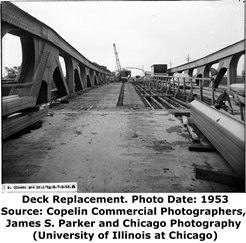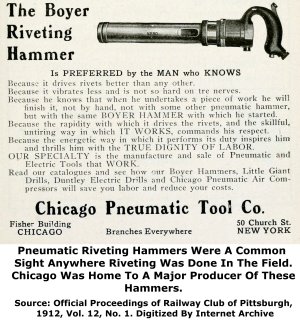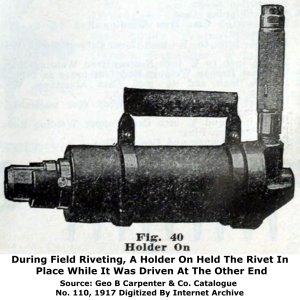We Recommend:
Bach Steel - Experts at historic truss bridge restoration.
BridgeHunter.com Phase 1 is released to the public! - Visit Now
Cicero Avenue Bridge

Primary Photographer(s): Nathan Holth
Bridge Documented: August 12, 2006 and September 2011
Chicago: Cook County, Illinois: United States
Metal Rivet-Connected Pratt Pony Truss, Movable: Double Leaf Bascule (Strauss Trunnion) and Approach Spans: Metal Stringer (Multi-Beam), Fixed
1927 By Builder/Contractor: Unknown and Engineer/Design: Strauss Bascule Bridge Company (Strauss Engineering Company) of Chicago, Illinois
1966
240.2 Feet (73.2 Meters)
304.0 Feet (92.7 Meters)
76 Feet (23.16 Meters)
1 Main Span(s) and 2 Approach Span(s)
16600927336

View Information About HSR Ratings
Bridge Documentation
Additional Information: Despite its appearance that is similar to bridges that follow the designs of the City of Chicago, this bridge in fact was designed by Strauss Bascule Bridge Company and has the patented design of the county, which included a counterweight trunnion in addition to the main trunnion. The two trunnions can be seen in the historical photo of the bridge widening below.
View Archived National Bridge Inventory Report - Has Additional Details and Evaluation
This bridge is noted as a rare example of a pony truss bascule bridge with three truss lines. A plaque on the bridge says the Cicero Avenue Bridge was "widened and modernized" in 1966. This refers to this bridge's interesting history. The bridge originally had two truss lines, and a third truss line was added in 1966 to widen the bridge. This third truss replicates the 1927 trusses exactly as it is not easily discernable as to which truss is the newer one. However, carefully looking at some of the new steel reveals a United States Steel logo on some of the steel. U.S. Steel did not use their logo in 1927 and instead used the names of its subsidiary mills. However by 1966 they were using their logo on steel. A 1949 advertisement shown below shows the United States Steel logo. Above, a photo shows the bridge prior to being widened.
This bridge is one of a number of bascule bridges on the Sanitary and Ship Canal that no longer raises. The bridge tender buildings have been removed, as well as the traffic gates. The only plaque on this bridge today is a plaque from the 1966 widening, mounted on the end of the truss, an unusual location among Chicago bascule bridges. A historical photo from before the widening clearly shows two plaques, one appearing to be a large typical city bridge plaque, and the other being a smaller plaque with unknown content. These plaques, now missing from the bridge, were also mounted on the ends of the truss, indicating that the unusual plaque locations on this bridge is something that predates the widening project.
Thanks to Tom Winkle for providing boat transportation to assist in the photo-documentation of this historic bridge.
Above: This photo shows the bridge under construction, but nearly completed.
Above: This photo shows the bridge in 1960, only a few years before it was widened.
Above: These photos from 1964 shows the widening project underway.
Side Note: Field Riveting
Truss bridges with riveted connections like the Cicero Avenue Bridge required riveting in the field where the members of the truss were riveted together at the connection gusset plates. Field riveting was usually accomplished with a pneumatic riveting hammer. While the hot rivet was being hammered, someone would have to use a holder on to hold the end of the rivet with the pre-formed shop head in place while the other end was hammered into shape. A holder on might be pneumatic or might simply rely on pressure applied by the worker. A pneumatic riveting hammer is shown above and a pneumatic holder on is shown below.
|
Rehabilitation Plaque S. CICERO AVE.BRIDGE BUILT 1927 WIDENED AND MODERNIZED 1966 CITY OF CHICAGO RICHARD J. DALEY MAYOR MILTON PIKARSKY Commissioner of Public Works WALTER E. RASMUS Chief Engineer HARRY ZALEWSKI Asst. Chief Engineer Const'n
|
![]()
Historic Bridges of Chicago and Cook County


Chicago and Cook County are home to one of the largest collections of historic bridges in the country, and no other city in the world has more movable bridges. HistoricBridges.org is proud to offer the most extensive coverage of historic Chicago bridges on the Internet.
General Chicago / Cook County Bridge Resources
Chicago's Bridges - By Nathan Holth, author of HistoricBridges.org, this book provides a discussion of the history of Chicago's movable bridges, and includes a virtual tour discussing all movable bridges remaining in Chicago today. Despite this broad coverage, the book is presented in a compact format that is easy to take with you and carry around for reference on a visit to Chicago. The book includes dozens of full color photos. Only $9.95 U.S! ($11.95 Canadian). Order on Amazon.
Chicago River Bridges - By Patrick T. McBriarty, this is a great companion to Holth's book shown above. This much larger book offers an extremely in-depth exploration of Chicago's movable highway bridges, including many crossings that have not existed for many years. Order Now Direct From The Publisher! or order on Amazon.
View Historic American Engineering Record (HAER) Overview of Chicago Bascule Bridges (HAER Data Pages, PDF)
Chicago Loop Bridges - Chicago Loop Bridges is another website on the Internet that is a great companion to the HistoricBridges.org coverage of the 18 movable bridges within the Chicago Loop. This website includes additional information such as connections to popular culture, overview discussions and essays about Chicago's movable bridges, additional videos, and current news and events relating to the bridges.
Additional Online Articles and Resources - This page is a large gathering of interesting articles and resources that HistoricBridges.org has uncovered during research, but which were not specific to a particular bridge listing.
![]()
Photo Galleries and Videos: Cicero Avenue Bridge
2011 Bridge Photo-Documentation
Original / Full Size PhotosA collection of overview and detail photos. This gallery offers photos in the highest available resolution and file size in a touch-friendly popup viewer.
Alternatively, Browse Without Using Viewer
![]()
2011 Bridge Photo-Documentation
Mobile Optimized PhotosA collection of overview and detail photos. This gallery features data-friendly, fast-loading photos in a touch-friendly popup viewer.
Alternatively, Browse Without Using Viewer
![]()
2006 Bridge Photo-Documentation
Original / Full Size PhotosA collection of overview and detail photos. This gallery offers photos in the highest available resolution and file size in a touch-friendly popup viewer.
Alternatively, Browse Without Using Viewer
![]()
2006 Bridge Photo-Documentation
Mobile Optimized PhotosA collection of overview and detail photos. This gallery features data-friendly, fast-loading photos in a touch-friendly popup viewer.
Alternatively, Browse Without Using Viewer
![]()
Maps and Links: Cicero Avenue Bridge
Coordinates (Latitude, Longitude):
Search For Additional Bridge Listings:
Bridgehunter.com: View listed bridges within 0.5 miles (0.8 kilometers) of this bridge.
Bridgehunter.com: View listed bridges within 10 miles (16 kilometers) of this bridge.
Additional Maps:
Google Streetview (If Available)
GeoHack (Additional Links and Coordinates)
Apple Maps (Via DuckDuckGo Search)
Apple Maps (Apple devices only)
Android: Open Location In Your Map or GPS App
Flickr Gallery (Find Nearby Photos)
Wikimedia Commons (Find Nearby Photos)
Directions Via Sygic For Android
Directions Via Sygic For iOS and Android Dolphin Browser
USGS National Map (United States Only)
Historical USGS Topo Maps (United States Only)
Historic Aerials (United States Only)
CalTopo Maps (United States Only)













